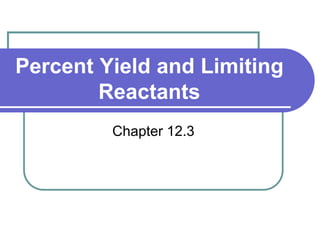
Percent Yield and Limiting Reactants.ppt
- 1. Percent Yield and Limiting Reactants Chapter 12.3
- 2. Percent Yield The percent yield is the percentage of a certain product actually produced in a chemical reaction. The theoretical yield is predicted by a stoichiometry problem.
- 3. A. Percent Yield 100 yield l theoretica yield actual yield % calculated on paper measured in lab
- 4. A. Percent Yield When 45.8 g of K2CO3 react with excess HCl, 46.3 g of KCl are formed. Calculate the theoretical and % yields of KCl. K2CO3 + 2HCl 2KCl + H2O + CO2 45.8 g ? g actual: 46.3 g
- 5. A. Percent Yield 45.8 g K2CO3 1 mol K2CO3 138.21 g K2CO3 = 49.4 g KCl 2 mol KCl 1 mol K2CO3 74.55 g KCl 1 mol KCl K2CO3 + 2HCl 2KCl + H2O + CO2 45.8 g ? g actual: 46.3 g Theoretical Yield:
- 6. A. Percent Yield Theoretical Yield = 49.4 g KCl % Yield = 46.3 g 49.4 g 100 = 93.7% K2CO3 + 2HCl 2KCl + H2O + CO2 45.8 g 49.4 g actual: 46.3 g
- 7. Percent Yield The reaction between SO2 and oxygen yields SO3.. Calculate the percent yield of SO3 if 40.0 grams of SO3is formed, when 32 grams of SO2 react with an excess of oxygen. SO2 + O2 SO3 2SO2 + O2 2SO3 3 3 3 2 3 2 2 2 SO g 39.9916085 SO mole 1 SO g 80.0642 SO mole 2 SO mole 2 SO g 64.0648 SO mole 1 1 SO grams 32 3 3 3 SO 100.02% 100 SO g 39.9916085 SO g 40.
- 8. B. Limiting Reactants Available Ingredients 4 slices of bread 1 jar of peanut butter 1/2 jar of jelly Limiting Reactant bread Excess Reactants peanut butter and jelly
- 9. B. Limiting Reactants Limiting Reactant Is used up first Stops the reaction Determines the amount of product Excess Reactant added to ensure that the other reactant is completely used up cheaper & easier to recycle
- 10. B. Limiting Reactants 1. Write a balanced equation. 2. For each reactant, calculate the amount of product formed. 3. Smaller answer indicates: limiting reactant amount of product
- 11. Limiting Reactant Steps (version 2) 1 Step one o Write and balance the equation for the reaction. 2 Step two o Convert known masses to grams of product. 4 Step three o Determine limiting reactant and amount that can be made. 5 Step four o Determine the grams of excess from limiting reactant.
- 12. B. Limiting Reactants 79.1 g of zinc react with 55.4 g of HCl. Identify the limiting and excess reactants. How many liters of hydrogen are formed at STP? Zn + 2HCl ZnCl2 + H2 79.1 g ? L 55.4 g
- 13. B. Limiting Reactants 79.1 g Zn 1 mol Zn 65.39 g Zn = 27.1 L H2 1 mol H2 1 mol Zn 22.4 L H2 1 mol H2 Zn + 2HCl ZnCl2 + H2 79.1 g ? L 0.90 L 2.5M
- 14. B. Limiting Reactants 22.4 L H2 1 mol H2 0.90 L 2.5 mol HCl 1 L = 25 L H2 1 mol H2 2 mol HCl Zn + 2HCl ZnCl2 + H2 79.1 g ? L 0.90 L 2.5M
- 15. B. Limiting Reactants Zn: 27.1 L H2 Limiting reactant: HCl Excess reactant: Zn Product Formed: 25 L H2 left over zinc HCl: 25 L H2
- 16. Limiting Reagent or Reactant 2 (problem #2) How many grams of ammonia will be produced when 20.0 grams of potassium hydroxide react with 15.0 grams of ammonium sulfate? 2KOH + (NH4)2SO4 K2SO4 +2NH3 +2H2O
- 17. (NH4)2SO4 is the limiting reagent because it will make the least amount of product. It is the reactant that will run out first. produced. be will NH grams 3.87 Step3 3 3 3 3 4 2 4 3 4 2 4 4 2 4 4 2 4 3 3 3 3 NH grams 3.87 NH moles 1 NH grams 17.03052 SO ) (NH mole 1 NH moles 2 SO ) (NH g 132.14052 SO ) (NH mole 1 1 SO ) (NH g 15.0 NH grams 6.07 NH moles 1 NH grams 17.03052 KOH moles 2 NH mole 2 KOH g 56.10564 KOH mole 1 1 KOH g 20.0 2 Step